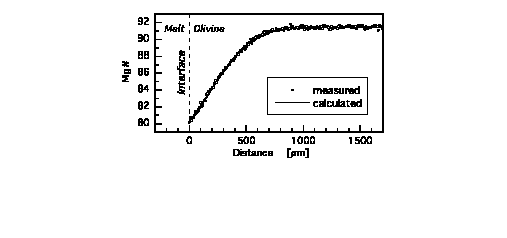
We have studied xenoliths from the 1949 and other historical eruptions on La Palma (Canary Islands) to calculate magma ascent rates. All harzburgite and dunite mantle nodules show two reaction time domains with their host melt, as documented by two types of fracture planes. Type 1 planes are angular or rounded and characterized by a 0.9-1.6 mm deep diffusion front in adjacent olivines, subparallel to the surface. Most show a reaction rim of diopside + kaersutite + Ti-magnetite. Type 2 planes are always angular, showing a diffusion front in olivine of 1-10 µm and no
reaction rims. Many are associated with melt-filled fractures, some of which exhibit a honeycomb-like melt pattern
generated by vesiculating melt.
The Fe-Mg interdiffusion process between olivine and host melt (Buening and Buseck, 1973) has been modelled to derive minimum diffusive contact times, using the Boltzmann-Matano-approach (Crank, 1975) and assuming T=1200°C and fO2=QFM-1.5 (Fig. 1). The results are 0.5-1.1 years for type 1 planes, and less than 1 hour for type 2 planes and melt-filled fractures, respectively. The degree of roundness of some type 1 planes indicates partial xenolith dissolution. True contact times may thus have been considerably longer than calculated.
The two clearly distinct contact time domains plausibly suggest a multi-stage magma ascent. Type 1 fracture planes represent an early nodule fragmentation event, probably the entrainment stage into the host magma, months or years prior to the eruption. This time range is comparable to the onset of the seismic precursors of the 1949 eruption, which were felt on the island since 1936 (Martel San Gil, 1960). In contrast, type 2 planes and melt-filled fractures were formed only minutes prior to the eruption, indicating rapid magma ascent. This particular type of nodule fragmentation process can be explained at best by decompressive strain fracturing and subsequent melt intrusion.
We conclude that the diffusive exchange between olivine and host melt provides an important tool to reconstruct the kinetics of magmatic processes within the time interval of hours to years.
Buening, D.K. & Buseck, P.R., J. Geophys. Res. 78, 6852-6862 (1973).
Crank, J., The Mathematics of Diffusion (Oxford Univ. Press, Oxford, 1975).
Martel San Gil, M., El Volcan de San Juan (Madrid, 1960).
Fig. 1: Measured (dots) and calculated (line) diffusion profile in marginal olivine of harzburgite xenolith, perpendicular to the olivine-melt-interface. Mg#=Mg/(Mg+Fe), calculated from electron microprobe analyses.